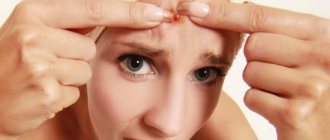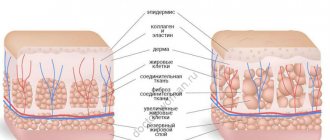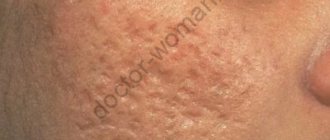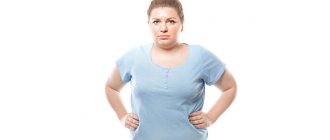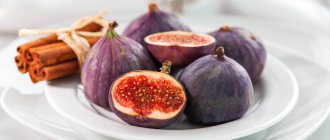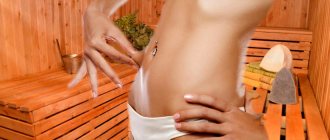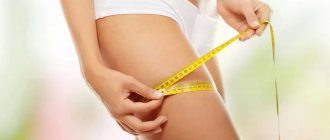What is acne
Acne is a closed inflammation that develops under the surface of the skin. They may look like:
- Papules are painful red bumps.
- Pustules are red bumps with a white abscess on top.
- Nodules are nodular formations that are hard to the touch and look like subcutaneous tubercles.
- Cysts are clusters of nodules.
Where do they come from?
- It all starts with comedones - this is what they call a mixture of dead skin particles, impurities and cosmetic residues that clog the sebaceous ducts.
- Inside the comedon, ideal conditions are created for the development of propionbacteria (they are the ones that provoke inflammation). This is, firstly, the lack of oxygen, and, secondly, the constant replenishment of sebum, which continues to be released and accumulate under the sebaceous plug.
- As a result, bacteria multiply and provoke inflammation - this is how acne appears. They are often called “closed comedones” precisely because all the processes occur below the surface of the skin.
How to remove scars, scars?
Once the keloid scars are surgically removed, clips are applied to those areas. They do not allow collagen to be released in large quantities. If scars appear on the ears or lips, then treatment is carried out using pressure. Corticosteroids will also help remove such irregularities. Usually this technique is used simultaneously with surgery. Dexamethasone or triamycin is injected into the scar. This kind of procedure is carried out until the desired result is achieved.
Typically, atrophic scars appear after acne and chickenpox. And here the treatment depends directly on how long ago the scars appeared and the size of these formations. In case of small scars, injections are given. Preparations based on hyaluronic acid are injected into the scars. They dissolve and fill the space. But here the effect is temporary, so this procedure must be repeated every 6 months. Even in the case of atrophic defects, scar correction is proposed using peeling or grinding:
- laser resurfacing. The structure of the scar becomes denser, the scar tissue is burned using a laser. In action it resembles peeling, but this procedure is carried out in relation to shallow scars. Anesthesia is used for the procedure;
- Z-plasty. Here the scar is excised surgically. This is done if the person has very large scars;
- microdermabrasion. This is an abrasive type peeling. Here the skin is treated, but not very deeply. Therefore, the patient does not feel pain during the procedure;
- dermoburasia. This is a mechanical peeling. It will help remove any scars. Anesthesia is used for this.
How are small scars on the face smoothed out? It is worth remembering about ultrasonic facial skin cleansing. This is a painless procedure that is carried out in various beauty salons. It does not entail any complications, therefore it is popular among women and men. In addition to removing scars and scars, this procedure will make the skin more elastic, smooth, and firm. You will look beautiful. But it is important to remember that ultrasonic facial cleansing can only be carried out by a professional!
Types of imperfections on the face
In addition to acne, there are other types of inflammation, but all of them are somehow associated with blockage of the sebaceous ducts and/or increased sebum production. What is the difference?
Acne
One pimple is not yet acne. But if they spread all over the face and clump together... This means that we are not talking about a one-time inflammation, but about a serious disease that needs to be treated with the support of specialists - a dermatologist, gynecologist, endocrinologist, cosmetologist and gastroenterologist. If acne is started or treated incorrectly, scars and scars may remain on the skin - post-acne.
Black dots
Blackheads are called “open comedones.” The mechanism of their occurrence is the same as that of acne, but the process occurs not under the skin, but on its surface. By the way, blackheads do not become black because of a large amount of dirt: the reason is the oxidative process that occurs when the sebaceous plug and oxygen interact.
Acne
Essentially, blackheads are blackheads that were not removed in time (we have already mentioned that a mixture of sebum and pollution is an ideal environment for the development of bacteria). If you notice acne on your face, do not peel under any circumstances! During the process of exfoliation, you can spread bacteria all over your face and cause acne.
Subcutaneous acne: causes, symptoms, treatment
Unlike ordinary rashes, subcutaneous acne is a problem that is almost impossible to get rid of quickly and easily. They form deep under the dermis, take a long time to mature, are quite painful, attempts to squeeze them out on their own do not bring success, and even if they do, after such manipulations, marks in the form of scars, hyperpigmentation or fistulas remain on the skin for a long time.
Therefore, it is extremely important not to try to remove such an internal pimple on your own and with folk remedies at home, but to promptly seek qualified help. At the Private Practice clinic, treatment is provided by a highly qualified dermatovenerologist, cosmetologist, candidate of medical sciences Valeria Borisovna Yamshchikova. Our doctor has only highly effective and practice-tested treatment methods that successfully solve this problem without consequences or relapses. You can get advice and make an appointment by calling the indicated phone numbers.
Why do subcutaneous acne appear? Common reasons
The occurrence of deep internal formations is almost independent of hygiene. Here the premises are more serious. Traditionally this is:
- endocrine disorders in the patient’s body - during puberty, pregnancy or menopause, taking hormonal contraceptives, dysfunction of the thyroid gland or adrenal glands;
- disruptions in the functioning of the gastrointestinal tract;
- disruption of the sebaceous glands, hyperhidrosis, decreased immunity;
- autoimmune and dermatovenerological diseases;
- unbalanced diet with a bias towards simple carbohydrates, saturated and transgenic fats;
- abuse of deep peels.
In addition, the cause of subcutaneous acne can be demodex (subcutaneous mite). Excluding demodicosis is the first step in the treatment of formations of this kind.
How to recognize a subcutaneous pimple?
At the first stage, the formation is not visually noticeable. There may be slight redness of the epidermis and discomfort when pressing on a certain area. After some time, a compaction can be felt in this place, which gradually increases.
Over time, it becomes noticeable to the eye, and the subcutaneous pimple looks like a bump - a uniform reddish tubercle without a black or white top. Its ripening time may take several weeks. In addition, maturation may stop at one stage or another. In this case, the internal pimple resolves and disappears over time. But don’t think that this is a victory - sooner or later it will appear nearby or in a related area.
Such acne can appear on any part of the body - neck, shoulders, chest, abdomen, buttocks, inner thighs, scalp. Sometimes they can be observed in the armpits and in the face area. Most often, internal acne on the face forms in the chin area: the skin here is the densest, so it is difficult for the formation to “break through” to the outside.
Diagnosis and treatment of acne under the skin in our medical center
Any patient facing the problem described can turn to us for help. To begin with, Dr. Yamshchikova will conduct an examination to identify the causes of subcutaneous acne. This may include the following procedures:
- skin biopsy or tape test to exclude demodicosis;
- blood tests - general, biochemical, hormonal, immunological;
- Ultrasound of internal organs;
- consultations with specialized specialists, for example an endocrinologist.
After the cause of acne under the skin has been determined, the competent doctors of our Private Practice clinic select and prescribe the most effective comprehensive treatment. It includes therapy aimed at improving the functioning of problematic systems and organs to prevent the appearance of new acne, combating existing formations, as well as procedures to restore damaged skin.
Make an appointment at a convenient time and receive qualified medical care!
You can make an appointment with a doctor by calling
+7+7 (495) 980-13-16
Causes of acne on the face
Contrary to stereotypes, acne (both small and large) does not only affect teenagers. Nasty lumps can occur in women and men at any age, even infancy! Why does the skin suddenly begin to “bloom”?
Among women
- Hormonal disbalance. Hormones can go crazy, for example, during pregnancy or menopause.
- Genetic predisposition. Most often, acne affects those with oily or combination skin types, which are known to be inherited.
- Poor nutrition. “Dangerous trinity” - flour, fatty, sweet. Try removing it from your diet, and your face will become noticeably cleaner!
- Incorrect care. The main stages of caring for problem skin include cleansing, deep cleansing (exfoliation), makeup removal, toning and moisturizing. You can't miss any of them! At the same time, the composition of cosmetics must contain sebum-regulating and bactericidal components: zinc, salicylic acid, eucalyptus or black elderberry extract, activated carbon, clay, etc.
- Digestive problems. A gastrointestinal disorder can lead to an imbalance of intestinal microflora and the accumulation of toxins that negatively affect the condition of the skin.
- Stress. At the most inopportune moment, a pimple popped up in a visible place? The law of meanness has nothing to do with it: it’s just that the stress hormone cortisol also affects sebum production.
- Bad habits. These are, first of all, smoking, alcohol, poor drinking habits and sleepless nights.
In men
- Lack of care or improper care. Due to the large number of sebaceous glands, men's skin almost always suffers from oiliness. Add to this the abundance of testosterone, which stimulates sebum production, and you will have no questions left about where men get acne.
- Shaving. If bacteria get into the wound after shaving, inflammation is not far off.
In children and adolescents
- Hormonal disbalance. During puberty, adolescents begin to undergo global hormonal changes, and the level of testosterone and dihydrotestosterone production increases. And they, in turn, provoke excessive secretion of sebum. Voila, here you have acne! Most often, inflammation in adolescence occurs in the T-zone: this is where most of the sebaceous glands are located.
- Infant acne. The appearance of pimples on the face of infants is associated with imperfections in the excretory system and an excess of maternal hormones. There is no need to treat them: if hygiene standards are observed, they will go away quite quickly on their own.
Prevention of acne and pimples
Prevention of acne and pimples includes proper balanced nutrition, diet, and regular skin care. During the period of greatest activity of the sebaceous glands (especially in adolescence and youth), exclude fatty foods rich in simple carbohydrates, sweets, and starchy foods from your diet. Alcohol and cigarette consumption also affect skin condition. Therefore, they should also be abandoned. In addition, do not forget about regular cleansing of your skin. Use antiseptic masks and creams.
Do not squeeze blackheads and pimples. By doing this, you can provoke even more of their appearance and the appearance of scars and scars.
These simple rules will help keep your skin pores clean and prevent dust and bacteria from getting into them, which contribute to the development of inflammation.
How to properly remove pimples from your face
To remove acne from your face at home, it is important to remember and follow three important beauty rules.
RULE No. 1
Do not squeeze out red inflammation!
First, let the pimple “mature” and draw up a comprehensive plan to destroy the enemy. RULE No. 2
Provide your skin with proper care:
- Cleansing. Look for gels and foams with sebum-regulating and bactericidal components. Makeup remover products should have an oil-free base.
- Deep cleansing. Do not use scrubs during periods of exacerbation. If your skin is often inflamed, try creams with acids that will provide the most gentle exfoliation.
- Toning. Tonic will help wash away any remaining impurities and makeup, cleanse pores and prepare the skin for the next stage of your beauty routine.
- Hydration. If your facial skin is dehydrated, the sebaceous glands begin to secrete even more sebum, so be sure to moisturize your skin. Must have in the composition is hyaluronic acid.
- Additional care. Two or three times a week, pamper your skin with masks with a mattifying effect: for example, based on clay or activated carbon.
RULE No. 3
If acne covers your entire face and has spread to your shoulders and chest, be sure to consult a cosmetologist!
Is it possible to get rid of acne quickly?
What to do if you need to get rid of hated acne as soon as possible? We reveal the most effective methods of care!
How to get rid of acne on your face in a week
A week is enough time to develop a program to combat acne together with a cosmetologist!
- CARE Use home care cosmetics for problematic facial skin. It is less traumatic than, for example, salicylic acid in its pure form. And don't forget about hydration - this is the foundation!
- HYGIENE Wash your face twice a day with gel or foam and dry your face with paper towels. Fabrics can be carriers of bacteria.
- TESTS Get tested for hormones, as well as general and biochemical blood tests. Discuss them with your cosmetologist.
Acne in adulthood
28.01.2021
This inflammatory skin disease worries not only teenagers. Unfortunately, this problem for some women does not stop even when the first wrinkles appear.
25% of women after forty and 15% after fifty have age-related acne .
But these pimples are different from teenage acne Most often, this is cystic acne - voluminous ulcers on the forehead, chin, and wings of the nose . Either these are black dots , they do not turn red or become inflamed, but they look unattractive.
Causes of acne
In adulthood, acne appears due to the following factors, which are superimposed on the skin's predisposition to accumulate sebum:
- stress;
- heredity;
- hormonal changes;
- some medications.
Basic measures to combat acne
Inflammation occurs after sebum enters the pore, clogging the pore and oxidation of sebum, which leads to inflammation - a blackhead or white abscess.
Therefore, skin care includes the following:
- cleansing pores;
- destroying bacteria, stopping skin infections;
- decreased sebum production;
- acceleration of cell renewal;
- acne treatment .
Pore cleansing
Products with salicylic acid are good for cleansing pores. This product should be used twice a day – morning and evening.
Salicylic acid cleanses pores, tightens them, and thereby stops the appearance of blackheads and pimples . It dries the skin and removes excess sebum, salicylic acid is fat-soluble, so it penetrates through sebum, destroys it and prevents clogging of pores.
Destruction of bacteria
Ulcers, inflammation, red swollen pimples appear from blackheads if there are bacteria in the clogged pores. An infection develops, pus appears, then other means are needed in addition to salicylic acid. Cleansers and creams with benzoyl peroxide work well against bacteria - this substance has an anti-inflammatory effect and removes excess sebum.
Acceleration of cell renewal
In this case, using a prescription drug based on tretinoin, you can solve two problems at once: skin aging and age-related acne . The fact is that such creams are anti-aging, their main effect is the renewal of the upper layers of skin cells. And at the same time, this solves the problem of age-related acne - natural cleansing of the pores occurs. Among over-the-counter medications, cosmetologists offer creams with retinol - they are quite effective. They must be applied in a thin layer so as not to clog the pores.
Acne treatment
In adulthood, acne is mainly of cystic origin and looks like voluminous white ulcers. In addition to requiring care and treatment for long-term effects, it is also necessary to mask or reduce the visibility of acne here and now. For these purposes, you need to know both professional means and be able to use homemade - practically improvised - means.
- Cortisone injections - the drug is injected by a cosmetologist into the pimple and provides a healing and healing agent. There will be no immediate effect, but within 2-3 days the pimple will completely disappear and the likelihood of its reoccurrence will decrease.
- Dietary supplements with zinc – 30 mg – a daily dose of zinc reduces acne , zinc has an anti-inflammatory effect. Together with taking oral antibiotics prescribed by a specialist, vitamins with zinc stop the development of acne .
- Toothpaste – Smooth white toothpaste actually improves acne- . If you apply toothpaste to a pimple at night, in the morning it will dry out and turn pale.
- Another home option is a patch. A pimple, like wounds, sometimes heals better under a bandage . The patch is applied to pimples without an abscess overnight, which reduces redness and inflammation.
Of course, home treatment methods must be combined with medical treatment of the problem.
If medications and methods do not help, then you need to consult a dermatologist . The most effective way to treat acne in adults is to take hormonal medications, the type and dose of which can only be selected by a specialist.
Published in Dermatology Premium Clinic
How to get rid of acne at home using cosmetics
To get rid of acne forever, stock up not only with patience, but also with a decent arsenal of skincare products with sebum-regulating, exfoliating and anti-inflammatory ingredients. The minimum program is a gel or foam cleanser, makeup remover, toner, scrub and face mask.
What to do if you urgently need to get rid of a pimple?
The fastest option for dealing with a pimple is squeezing.
The process itself must be carried out following strict rules. But this does not guarantee a positive outcome. The resulting hole becomes an open path for bacteria, which, if deeply penetrated, can cause inflammatory processes or even blood poisoning. Proper treatment of the pimple removal site will help to avoid negative consequences.
One of the popular methods is the rapid removal of an inflamed point using toothpaste. To do this, just apply toothpaste to the affected area and leave for 5-7 minutes. After the time has passed, press a sponge soaked in hot water onto the pimple. After 2 minutes, you can wash off the remaining paste. In most cases, the pimple disappears.
You can use several other popular methods, but the situation with the appearance of acne needs to be assessed sensibly. Home methods are good only in the case of a single formation of inflamed areas. If the problem occurs frequently and the affected areas increase in size, then you should immediately consult a doctor.
How to remove acne on the face overnight using folk methods at home
If a defect in appearance appears late in the evening, you need to get rid of it, but you don’t have the above-mentioned medications at home, then you can use a large arsenal of home remedies.
Toothpaste
Ordinary toothpaste will help get rid of an insidious pimple: it will dry out the acne and relieve inflammation. The reason for this effect is the presence of silicon dioxide, known for its sorbing effect. The toothpaste is applied in the evening and left overnight, washed off in the morning, and the skin is moisturized. It is necessary that the paste does not dry out, so a film is applied to the area, fixing it with a band-aid.
Gel pastes or those containing dyes are prohibited.
Sea salt
Sea salt will quickly dry out an inflamed pimple. For the solution, measure out two tablespoons of water, stir in sea salt (one teaspoon). Soak a cotton swab in the liquid, apply exclusively to the inflamed area, and wash off in the morning with warm chamomile decoction or water.
Tea tree oil
Melaleuca essential oil is a component of a large number of cosmetic products designed to combat skin problems. But oil in its pure form is more effective. A few drops of tea tree oil applied at night are enough to make even very large inflammations less noticeable. You can get rid of small ones almost instantly. Often this oil along with lemon juice is added to a honey mask: take an equal volume of both, and add two drops of essential oil to enhance the effect.
Binders
This group of chemicals has many positive qualities. They reduce the secretion of sebaceous glands, have an anesthetic effect, tighten pores, and relieve irritation. They have a drying effect, so it will be easier to get rid of the defect or disguise it.
Among the plants, the most famous are:
- arnica (inflorescences);
- banana (peel);
- witch hazel (branches, bark);
- oak (bark);
- St. John's wort (herb);
- lemon (juice);
- chamomile (flowers);
- green and black tea;
- sage (leaves).
Tea, decoctions and infusions are made from these raw materials. Lemon juice is prepared immediately before application. Use the liquid as a lotion or compress at night, and wipe problem areas during the day.
other methods
You can hide acne or completely get rid of the problem in other ways:
- Parsley juice is applied to problem areas - both during the day and at night. For oily skin, mix it with lemon juice. Plantain juice has a drying effect.
- Freshly squeezed aloe leaf juice will soothe and disinfect the skin. Applied at night, it will eliminate redness. It is used as an antiseptic: the skin is treated after mechanical removal of acne.
- Tar soap is often used in the treatment of acne. It disinfects the skin, preventing the appearance of new defects. Before going to bed, carry out the following procedure: soap your palms, lather well, massage your face, leave for 10 minutes, rinse.
- A honey and cinnamon mask is traditional for problem skin. Half a teaspoon of powder is mixed with a tablespoon of honey, applied to the inflamed area, kept for a quarter of an hour, washed off with warm water and rinsed with cool water. The mixture will help eliminate single pimples.
- One egg gives two ways to get rid of the problem at once. The first of them is whipped egg white. Apply it to the affected areas in the evening, leave it overnight, and wash it off with warm water in the morning. The film helps get rid of inflammation, which is carefully separated from the shell and glued to the skin while wet in the evening, and removed the next day.
Not all methods and products will help get rid of particularly large pimples, but it will be much easier to disguise them. In the future, it is better to adhere to a balanced diet, exercise regularly, and devote enough time to skin care. Then you won’t have to deal with a cosmetic defect.
